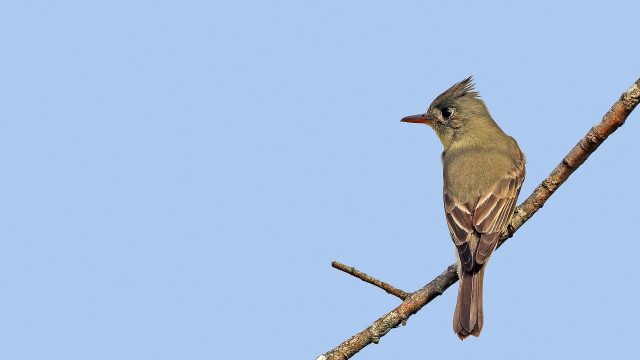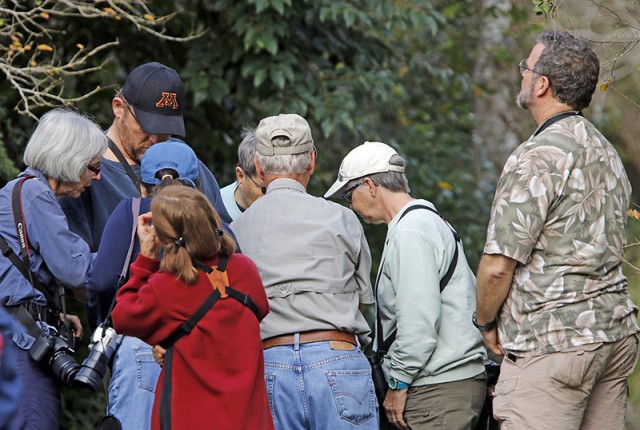
This Greater Pewee, a large, gray flycatcher with a crest on its head, wandered from the montane pine forests of central Mexico to greet visitors at the entrance of Lion’s/Shelley Park in Refugio. This species has only been seen a few times in Texas since records have been kept. Birders have been flocking to south Texas to observe this individual and two other rarities (Golden-crowned Warbler & Flame-colored Tanager) presently spending the winter in the park. Robert Benson photo.
22 Jan 2016 – Twitching For the Fun of It
We did something recently that we haven’t done in a while. We went “twitching.” Now, by “twitching” I do not mean involuntary muscle action, although it originally was used to describe the jerky, nervous behavior of one Howard Medhurst.
Medhurst was a British birdwatcher. He and his friends often took off looking for birds via motorcycle. It was cold, and getting off the motorcycle he would shiver, but also quivered with excitement (i.e. he twitched.) He was the first person branded a twitcher (by his friends!) In the 1950s, to twitch came to mean “the pursuit of a previously located rare bird.” To go twitching is to chase after a rare bird with the specific goal of seeing it and then counting it on a list. Medhurst travelled long distances with the express purpose of seeing birds he could add to his life list.
You have heard of a “life list,” haven’t you? A life list is another birdwatcher’s term. It is a list of all the bird species you have ever seen in your life. This list can be kept in a notebook, on the computer, or even by checking off species in a field guide.
Birders tend to keep a lot of lists: yard lists, trip lists, country lists, year lists, as well as that lifetime list. Life lists can easily get to be several hundred species long, even if the birder does not travel to birdwatch. And enough travelling certainly swells that list into the thousands. Everybody wants to see more species than anyone else, particularly within a small window of time. It can get quite competitive. This is how twitching was born.
We birders want to see as many different species as possible. A rare bird is one that is NOT supposed to be in a specific place during that specific time. This means you may be able to add a bird to your list without the usual amount of effort and expense. In a way, it is a “freebie.” You just have to go to where it was seen and look for it.
Rare bird alerts are maintained by phone, e-mail, and internet. Birders, who want to add that bird to their own lists, sometimes travel long distances to see the bird and count it. In other words, they “twitch.”
We heard of two rare birds being seen in Lion’s/Shelley Park in Refugio, Texas. One was a Greater Pewee, a flycatcher from the montane forests of Mexico, and the other a Golden-crowned Warbler, a small bird of the lowlands of Mexico and Central America. Both of these species are considered unlikely in South Texas in the winter. There are about 25 records of the pewee in Texas, but only about 8 for the warbler. So these were definitely rare birds. And they were “twitchable” meaning that they were being seen by a number of alerted birders.

This group of birders (sometimes called “twitchers”) consult photographs in a bird field guide after catching a glimpse of a Flame-colored Tanager last Wednesday at Lion’s/Shelley Park in Refugio. Some of these enthusiasts have traveled hundreds of miles to see this bird that they now can add to their life lists. Robert Benson photo.
We had to go and try for these birds. As we wandered around the park, we soon noticed we were not alone. Other binocular-clad individuals were walking along the trails. And there were lots of birds: several hundred American Goldfinches (I only have 8 coming to my feeder), numerous Great Kiskadees, several Yellow-rumped Warblers, and lots of bird noises. I rounded a corner and there were 10 people glued to the path, their eyes on a thick clump of ligustrum. They kindly waved me closer so I could see the bird too. I stared at the vegetation. After a few moments, I got a glimpse of a bird with mustardy-yellow coloration. I could see that it was a tanager. Surely this group of birders did not think this was the warbler! I ventured, “What bird is it you are looking for here?” They looked at me curiously and said, “The Flame-colored Tanager, of course.”
A Flame-colored Tanager, indeed! Another rare bird in the same park! All these twitcher/birders were way ahead of me. But the tanager flew off before I got a second look. All I could confirm was that the tanager had a head. I “dipped out” on that rarity.
I wandered on. Soon the trail became less well-marked and then disappeared altogether. I saw a few cardinals and a kinglet. The day was getting warm. I began to think about the 10 essentials you should always take with you on any hike, even a short one: Water? No. Map? No. I didn’t even want to think of the other eight I didn’t have. And where was my husband?
Robert has always been able to locate twitchable birds, well before I do. He was probably looking at one right now…on the other side of the park. I backtracked until I found the trail. And then my husband found me. Predictably, he had not only seen one of the rarities, the Greater Pewee, he had photographed it!
He led me to the spot he’d last seen the bird. The bird had since flown (of course) but with the help of two competent ladies we relocated it. It was in a leafless tree in plain sight. The Greater Pewee was preening and posing. It briefly showed me those two cottony tufts on its back (like those of its close relative the Olive-sided Flycatcher.) It eyed an insect and made a short, dipping sortie to catch it. It snapped its bill and turned sideways so I could get a good look. Its white eye-ring and yellow lower mandible stood out. I drank in the sight of a bird I was otherwise not likely to see in my lifetime.
I was proud of myself; I had twitched a rare bird!
If you would like to offer comments, please click through to the discussion page
